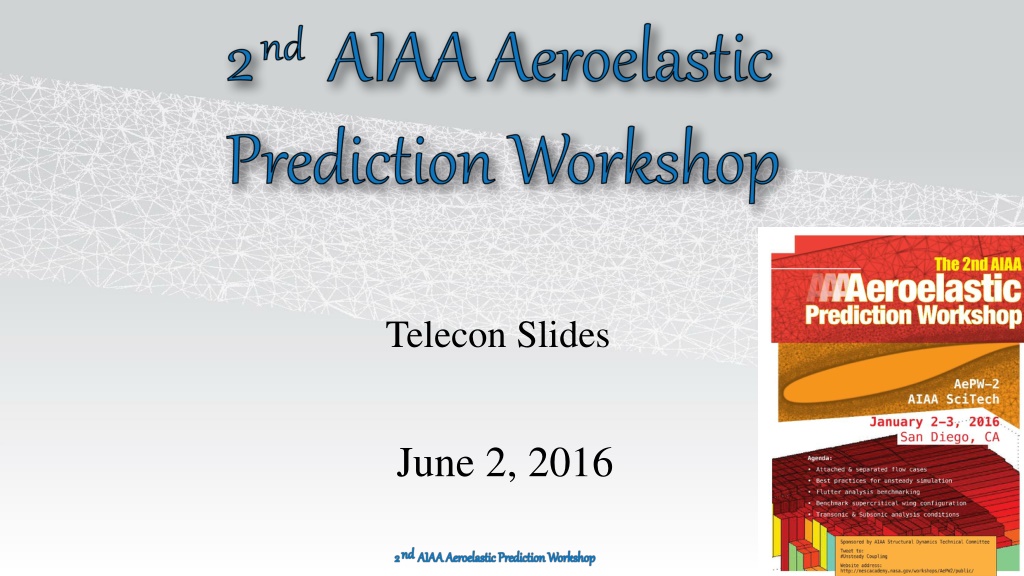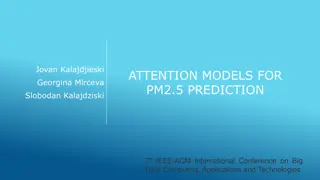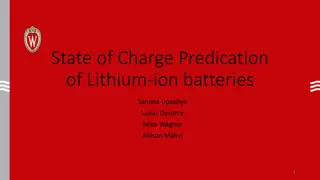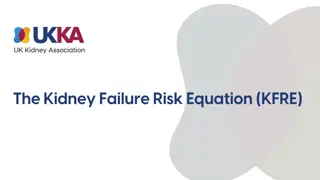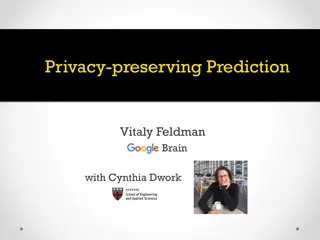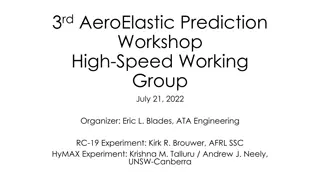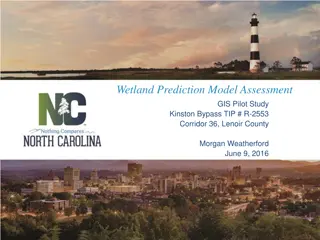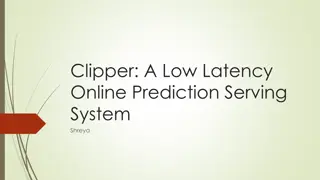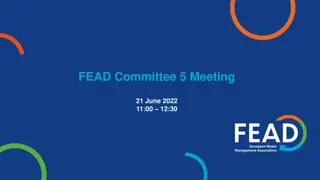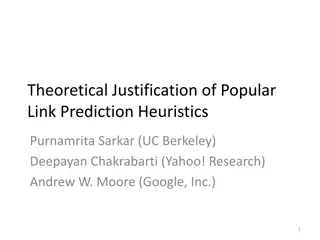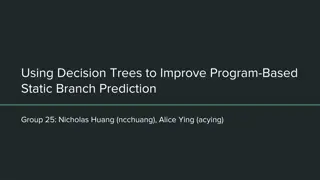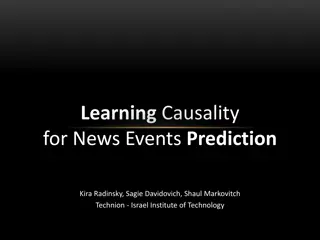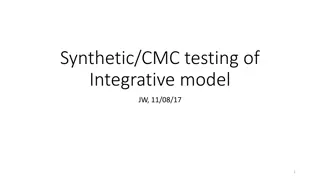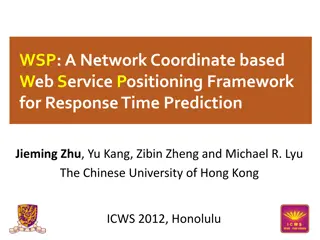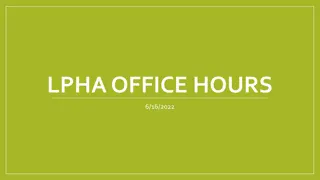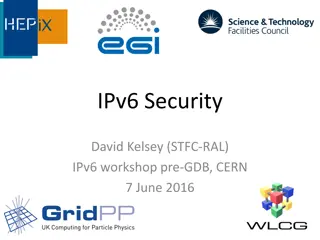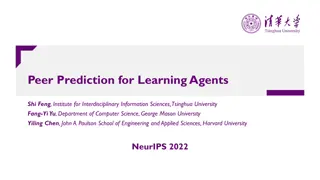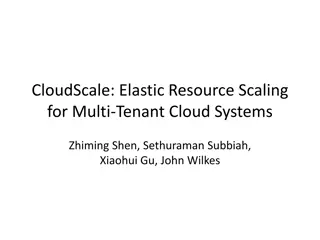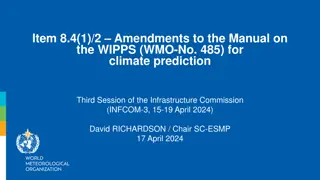Aeroelastic Prediction Workshop Updates - June 2016
Review the latest updates from the Aeroelastic Prediction Workshop's telecon held on June 2, 2016. Topics covered include agenda review, technical discussions, database comparisons, upcoming sessions, and presentation summaries. Stay informed about key dates and events related to the workshop and upcoming conferences.
Download Presentation

Please find below an Image/Link to download the presentation.
The content on the website is provided AS IS for your information and personal use only. It may not be sold, licensed, or shared on other websites without obtaining consent from the author. Download presentation by click this link. If you encounter any issues during the download, it is possible that the publisher has removed the file from their server.
E N D
Presentation Transcript
Telecon Slides June 2, 2016
Telecon agenda, June 2, 2016 Review of last telecon Administrivia Review since last telecon Updated data sets and database files What do we need to do next? Technical issues that we want to discuss Your technical issue that you want to discuss goes here Next telecon AUGUST 4, 11 a.m. Telecon notices will only be sent if the time or date moves. Otherwise, please plan to the first Thursday of the month at 11 a.m. U.S. east coast time. NO July Telecon 2
Summary of May telecon Website address: http://nescacademy.nasa.gov/workshops/AePW2/public/ Last telecon held May 5. Next telecon June 2, 11 a.m. East Coast time in U.S. Aviation special session abstracts shown; sessions as they existed on AIAA website shown. Dave Schuster and Daniella Ravey to co-chair each of the two sessions with Jen as co-chair. Special session at SciTech Jan 2017: abstracts due Monday June 6, 2016 Database comparison files had been distributed to each analysis team, showing only their results vs. experimental data. (May 4, 2016). Modified results for 4 teams were received and/or corrected. Telecons held and email correspondences to correct data 3
Presentations of AePW-2 material Presentation Aerospace Flutter and Dynamics Council meeting (Eric Blades, San Diego, Nov 5-6, 2015) Lots of opinions regarding path forward Presentation made of workshop summary to date at the Aerospace Flutter and Dynamics Council meeting (Washington D.C., May 12-13, 2016) Linear analysis seems to be good enough over most of the range of conditions. Presentation made of workshop summary to date to Boeing Technical Center of Excellence (March 2016) Presentations made of Aviation conference material to NASA (Hampton Virginia, USA, June 1, 2016) FUN3D results, Pawel Chwalowski Grid convergence: Are solutions grid converged? Current thoughts are that for STEADY distributed parameters, a 2D section analysis at ? Condition, requires 16M grid points for spatial convergence ; Limiter vs No Limiter: As you go to finer grid resolution, the limiter vs no limiter differences should disappear; Structural damping effect: Since none of the workshop analyses contained non-zero structural damping, is this something that should still be examined? A lot of the results from the workshop are below the experimental prediction. How much influence does this have? Temporal convergence: Lots of interest in what we did. Discussion regarding evaluation of different conditions. Overview, Jennifer Heeg Are there other presentations of material that we can add to this list? It would like to document this if practical.
Aeroelastic Prediction Workshop Schedule Key Dates: Computational Team Telecons: 1st Thursday of every calendar month 11 a.m. EST Re-analysis (and data set completion) results due Feb 28, 2016 Database needs to be generated by March 31, 2016 so that comparison data can be used in publications at Aviation conference 2016 AIAA Aviation Conference: Manuscript Deadline: 10 May 2016 Conference: June 13-17, Washington D.C. 2017 AIAA SciTech Conference Abstract Deadline June 6, 2016
Aviation special sessions Session #: APA-02 Session #: APA-08 Session Title: Results from the 2nd AIAA Aeroelastic Prediction Workshop I Session Time: June 13, 2016 from 9:30 AM to 12:30 PM Session Title: Results from the 2nd AIAA Aeroelastic Prediction Workshop II Session Time: June 13, 2016 from 2:00 PM to 5:30 PM
Aviation Special Session #1 Dave Schuster will chair (Jen will be co-chair)
Aviation Special Session #2 Daniella Raveh will chair (Jen will be co-chair) 3:00-3:30 Paper by Ames boys has been added to the session but doesn t appear yet in the program Open discussion possibilities: Data from the workshop Creating an aeroelastic validation experiment Fixing your data? For data sets that still have issues, is there a desire to work on this in real time on Monday afternoon Database usage? We will have the June 1 release of the data base files on the web in the next few days. Does anyone Want to hang out in the afternoon and go through how to use, sort, etc?
SciTech special session papers? Abstracts planned to be submitted: Ames Boys: AePW-2 workshop results Chwalowski: Numerical aspects of FUN3D BSCW simulations Heeg: Physics of the BSCW simulations in FUN3D and experiments Righi: Analysis of the results from RANS-LES turbulence models with the aim to understand what portion of the resolved turbulence spectrum is practically useful for aeroelastic problems / at what computational price Eric Blades (ATA): Workshop results and Limiter effects Embraer: computations using linear methods, Euler and URANS ? FOI? ANSYS?
SciTech 2017 Special Session Abstracts Title Control ID Authors Linking the physics and the data: Considerations of the computational and experimental data from the Aeroelastic Prediction Workshops 2550711 Jennifer Heeg, Pawel Chwalowski Numerical Investigations of the Benchmark Supercritical Wing in Transonic Flow 2550438 Pawel Chwalowski, Jennifer Heeg, Bob Biedron Effect of angle of attack and gas properties on flutter boundary of Benchmark Super-Critical Wing 2547890 Jan Navratil, Adam Jirasek, Mats Dalenbring Aeroelastic Simulations using ANSYS Multiphysics Software 2551284 Krishna Zore, Bala Sasanapuri, Eric Bish Plans and Suggestions for a Verification Case to the AIAA Aeroelastic Prediction Workshop 2548900 Cleber Spode, Eduardo S. Molina, Roberto Gil Annes da Silva Overset Grid Simulation for the Second AIAA Aeroelastic Prediction Workshop 2551854 Jeffrey A Housman, Cetin C. Kiris Analysis of Resolved Turbulent Scales of Motion in Aeroelastic Problems 2551338 Marcello Righi Aeroelastic Simulations for the Second Aeroelastic Prediction Workshop using Loci/CHEM 2552540 Eric Blades, A. Cornsh Development of an Enhanced OpenFOAM-based CFD Solver and its Application to Aeroelastic Problems Amin Fedeirooni 2552548
General material and prior telecon summaries 12
Next Steps? Are you interested in working on cooperative papers for SciTech? IFASD? We did this for the 2013 IFASD. It was work, but the combined publications were much better than any of the individual analysis papers. Statistical analysis of comparison results Data reduction and comparison of integrated quantity frequency response functions Going beyond AePW-2 to learn more about: Numerical damping effects (including temporal convergence requirement, influence of limiter) Does coupling method matter? Influence of separation? Do we have additional analyses, codes that can be applied to the Mach 0.85 5 deg case? Analysis across the Mach-alpha envelope Separate the effects of shock strength, shock location, lower surface aft loading Turbulence Models: Can we follow some of the logic and wisdom that Yuval offered? Higher fidelity analysis tools 14
NASA Management Highlight Ranges of High-Fidelity Computational Results Computational predictions of flutter onset showed good agreement with experimental data for the designated benchmarking test case (low transonic Mach number, 0 angle of attack (pink line in figure). Weak shocks and small separated flow regions were predicted at this condition. Linear predictions produced comparable results at this condition (blue line in figure). At the more aggressive optional analysis condition, where no experimental flutter onset data is available and the predicted flow conditions include strong shocks with dominant separated flow regions, the predictions varied widely (orange line in figure). Mach 0.74 Mach 0.85 Linear Analysis Results Experiment TDT operating envelope
Big Questions Remain Why do our flutter predictions for Case 3 vary so widely? What can we do to understand the underlying causes? What can we do to improve the predictions? Does the coupling methodology matter? (loose vs strong, using AePW-2 language) What are the critical features that induce flutter? Do these critical features vary by flow condition? (e.g. Shock formation, separated flow onset, separation-reattachment cycles and phasing, modal interactions) Process: How should we approach flutter solutions using current CFD methodologies? How should we recommend modification of CFD methodologies to better suit flutter prediction? 16
Some big picture comments & questions: Computational The process that we used to obtain flutter predictions from FUN3D was improvisational. We need something better. Process used required intensive matrix to differentiate Numerical vs Physical damping Desired: Integrated assessment of physical damping prediction Integrated process to drive system to a physical prediction of damping (rather than the primary result that we seemed to achieve which is a study of numerical damping) What is the right way to do temporal convergence? If I had it to do all over again, would I, could I: Perform Time-accurate analysis of the uncoupled flow field. Drive it until the answers (what parameter?) are constant? Choose some smarter parameter to examine rather than stability and single degree of freedom appearance of the generalized displacements and pitch angle? Find some reduced order method or sensitivity-based analysis to guide the CFD solution process? Convergence studies? Work harder at the typical section analysis, using those results to perform temporal convergence? Spatial convergence / Grid Adaptation for unsteady flows with grid motion: What is the right way? Unsteady flow modeling: Are there turbulence models appropriate, validated for unsteady flow? Structure-fluid coupling methodology and timing We have one result using EDGE that indicates that this doesn t matter for the EDGE implementation Is this code (implementation) dependent? Which codes have similar implementation? Different implementation?
Summary of April (and March) telecon Website address: http://nescacademy.nasa.gov/workshops/AePW2/public/ Last telecon held April 7. No telecon slides. Mini-telecons held to discuss individual data sets in the database and work on fixes. Next telecon May 5, 11 a.m. East Coast time in U.S. Details of updated files were included in the March telecon notes Details of instructions on updating and submitting files were given in March telecom notes Special session at SciTech Jan 2017: request submitted by Alessandro Scotti to Zahra Sotoudeh (SDTC lead for SciTech). Note that the SDTC chairmanship will turn over this year from Bruce Willis to Chad Hebert. 18
Summary of February 4, 2016 Telecon What do we need to do next? Workshop summary, in brief Technical issues that we want to discuss Your technical issue that you want to discuss goes here DDES grid now available Flutter boundary exploration with FUN3D Workshop debrief discussion What would we have liked to be different? What did we learn? What is being re-analyzed? (From whom should we be expecting additional results?) 19
Summary since Dec telecon Website address: http://nescacademy.nasa.gov/workshops/AePW2/public/ Last telecon prior to workshop held Dec 3, 2015 11 a.m. Matrix of results submitted by telecon were reviewed Discussion panel discussed- panel moderator, participants, title were confirmed Next telecon March 3, 11 a.m. East Coast time in U.S. Data submittal spreadsheets fed back to analysis teams with detailed instructions Workshop held Jan 2-3, associated with AIAA SciTech conference; organizational aspects provided by Megan Scheidt Discussion Panel held at SciTech, Jan 5 (Heeg, Raveh, Chwalowski, Righi, Schuster); organizational aspects provided by Joe Slater Report out to Structural Dynamics Technical Committee (Daniella Raveh, Jan 6) Special session at SciTech Jan 2017: request submitted by Alessandro Scotti to Zahra Sotoudeh (SDTC lead for SciTech). Note that the SDTC chairmanship will turn over this year from Bruce Willis to Chad Hebert. 20
Nov 19 telecon summary Held on Nov 19, 2015 11 a.m. Next telecon Dec 3, 11 a.m. East Coast time in U.S. Aviation conference special session approved. 8 abstracts submitted for session Panel session for SciTech is on the agenda for Tuesday afternoon, Jan 5 Discussed format, questions, moderator Status of data submittals to date (Nov 19) Data submittal Q&A Brief discussion of workshop agenda 21
October telecon summary Held on Oct 1, 2015 11 a.m. Next telecon November, 19 11 a.m. East Coast time in U.S. Administrative matters Workshop registration is open on AIAA website Possible special session at Aviation discussed, interest solicited. 5 teams responded positively on the telecon. Problems with the telecon number in Italy. Andrea Mannarino, Politecnico di Milano was going to discuss Case 2: Euler Results. Defer until Nov telecon Analysis results Case 1 FRFs submitted by 4 teams; comparison plots are included in the Oct telecon slides Added new results to Case 1 Integrated coefficients plots (included in this file) Processing discussion: Process overview and details 23
September telecon summary Held on Sept 3, 2015 11 a.m. Next telecon November, 5 11 a.m. East Coast time in U.S. Administrative matters Telecon slides now uploaded to website Deadline established for declaring participation as an analysis team: Oct 1 Advertisement blurb submitted to AIAA Analysis results Embraer discussed results for Case 1, both steady and forced oscillation FRFs Comparisons of steady coefficients for Case 1 were presented and discussed. Results separated by turbulence model, grid size and grid source are included in the Sept telecon slides. Consistent turbulence model study added to the analysis matrix: Case 2: Flutter at Mach 0.74, 0 angle of attack. For those running RANS analysis, utilize your code s standard Spalart-Allmaras turbulence model 24
August telecon summary Held on August 6, 2015 11 a.m. Next telecon October 1, 11 a.m. East Coast time in U.S. Administrative matters Telecon slides now uploaded to website Deadline established for declaring participation as an analysis team: Oct 1 Advertisement blurb submitted to AIAA Analysis results Jennifer Heeg showed (July telecon) unforced unsteady results for Case 3 (Mach 0.85, 5 ); Shock motion of ~9% of the chord for the unforced (no excitation) system is very similar using: EZNSS hybrid DDES (based on k-w SST) , shown by Daniella Raveh on June telecon FUN3D RANS + SA FUN3D URANS + SA Jennifer Heeg discussed (August telecon) frequency response function (FRF) Consistent turbulence model study added to the analysis matrix: Case 2: Flutter at Mach 0.74, 0 angle of attack. For those running RANS analysis, utilize your code s standard Spalart-Allmaras turbulence model Discussed the format and content of the panel discussion for SciTech 25
July telecon summary Held on July 2, 2015 11 a.m. Next telecon August 6, 11 a.m. East Coast time in U.S. Administrative matters Telecon slides now uploaded to website Deadline established for declaring participation as an analysis team: Oct 1 Advertisement blurb submitted to AIAA Analysis results Krishna Zore from ANSYS shared results- phase difference relative to experimental data noted; may be definition Jennifer Heeg showed unforced unsteady results for Case 3 (Mach 0.85, 5 ); Shock motion of ~9% of the chord for the unforced (no excitation) system is very similar using: EZNSS hybrid DDES (based on k-w SST) , shown by Daniella Raveh on June telecon FUN3D RANS + SA FUN3D URANS + SA Daniella Raveh from Technion showed results on the June telecon for Case 3: EZNSS RANS solutions showed dependence on the turbulence model Consistent turbulence model study added to the analysis matrix: Case 2: Flutter at Mach 0.74, 0 angle of attack. For those running RANS analysis, utilize your code s standard Spalart-Allmaras turbulence model Discussed the format and content of the panel discussion for SciTech 26
June telecon summary Held on June 11, 2015 11 a.m. Next telecon July 2, 11 a.m. East Coast time in U.S. Administrative matters Analysis team matrix updates continue Introduced SciTech panel discussion Analysis results Marcello Righi, Zurich University of Applied Sciences (ZHAW, ZUAS) Case 1: showed results using Edge and SU2 Unforced system shown as both average results from dynamic case and steady analysis Frequency response functions at forcing frequency & at higher harmonics; showed disagreement in the shock/divot region Daniella Raveh, Technion: Cases 2: Varied time step size, temporal convergence criteria and turbulence model Flutter frequency was slightly lower with a finer mesh; temporal convergence study showed increased damping with decreased time step size; good enough declared at time step size of 0.00024 seconds turbulence model changed the damping Solution hasn t converged to an oscillatory behavior at 1.5 seconds (~ 6 cycles); more iterations (global time steps) are needed Case 3: hybrid DDES shows unsteady flow with shock motion 27
May telecon summary Held on May 7, 2015 11 a.m. Next telecon June 11, 11 a.m. East Coast time in U.S. Discussed administrative matters AIAA coordination: Workshop will be held Saturday Jan 2 (3pm-6pm) & Sunday Jan 3 (8am-6pm) Workshop process Workshop agenda Discussed having a panel / discussion session at SciTech- during the conference week Analysis team matrix updates continue Suggested face to face at AIAA Aviation conference- not a lot of anticipated participation Corrected & updated workshop information from May Units on stiffness values Kh = 2637 lb/ft = 219.75 lb/in = 219.75 slinch/sec^2 Ktheta = 2964 ft-lb/rad = 35568 in-lb/rad= 35568 slinch-in^2/s^2/rad Corrected Reynolds number for Case 1 (Mach 0.7, 3 ) Rec = 4.56x106; Re = 3.456x106 28
AIAA Interactions Approved and signed off by Bruce Willis, Chairman of Structural Dynamics Technical Committee Megan Scheidt, Managing Director of Products and Programs 29
Envisioned Workshop Process for Analysis Teams (May, 2015) Perform analyses Submit results Prepare informal presentations for workshop SciTech 2016 AePW-2 Present results Results comparisons Discussion of results Path forward Panel discussion??? Re-analyze Publish at special sessions of conferences (which conferences?) Publish combined journal articles 30
April telecon summary Held on April 2, 2015 11 a.m. Next telecon May 7, 11 a.m. East Coast time in U.S. Updated analysis parameters matrix; uploaded to website Experimental data was added to website List of analysis teams produced Discussion of workshop dates Experimental data reduction showing divot in the FRFs to likely be physical Pawel showed animation of flutter solution at Mach 0.74 using FUN3D 31
March telecon summary Website address: http://nescacademy.nasa.gov/workshops/AePW2/public/ Held on March 12, rather than March 5 (with the usual March daylight savings time issues) Next telecon April 2, 11 a.m. East Coast time in U.S. SU-2 doesn t have existing FSI capability.(Melike and Dave Schuster to talk about this?) Block-structured grids from AePW-1 are available, generated by Thorsten Hansen at ANSYS. (Thorsten and Pawel will work together to make those available on the new website.) The molecular weight of R-134a isn t the same as a standard property table shows (102 g/mol). The value derived using the listed properties is more like 98 g/mol. This is due to the practical issue of gas purity that is achieved in the wind tunnel. The values on the table are from the test data, where the purity was likely 95% ish. (Pawel will add a line for molecular weight to the analysis parameters table.) Add the following to the table of analyses: ATA Engineering (Eric Blades will run LoPsiChem) AFRL (Rick Graves will run FUN3D) Milano Polytechnico (Sergio Ricci will run numerous codes) Please send comments regarding the distributed slides. In particular, are you okay with the abstract submittal form? With regard to submitting data to the workshop for comparison: Can you provide results in matlab? How do you feel about providing them in a data structure in matlab? Doublet lattice aeroelastic solution results: Bimo and Jen will work to present the results to date at the next telecon We will put the bulk data file, including the aero model and the flutter cards on the web site. This can serve as a basis for those who might want to use correction methods, etc. Temporal convergence results Organizations may not have the resources to perform the temporal convergence study for all grids. It is suggested that this be done for a grid resolution where things look to be spatially converged. Experience at NASA has shown qualitatively different results for the unstructured coarse grid than those observed for the finer grid resolutions. The flutter results at low Mach number (Mach 0.74) have shown great variation with regard to time step size. The predicted aeroelasticity stability of the system has been shown to be a function of the time step size and the subiteration convergence level. 32
March telecon summary Website address: http://nescacademy.nasa.gov/workshops/AePW2/public/ Held on March 12, rather than March 5 (with the usual March daylight savings time issues) Next telecon April 2, 11 a.m. East Coast time in U.S. SU-2 doesn t have existing FSI capability.(Melike and Dave Schuster to talk about this?) Block-structured grids from AePW-1 are available, generated by Thorsten Hansen at ANSYS. (Thorsten and Pawel will work together to make those available on the new website.) The molecular weight of R-134a isn t the same as a standard property table shows (102 g/mol). The value derived using the listed properties is more like 98 g/mol. This is due to the practical issue of gas purity that is achieved in the wind tunnel. The values on the table are from the test data, where the purity was likely 95% ish. (Pawel will add a line for molecular weight to the analysis parameters table.) Add the following to the table of analyses: ATA Engineering (Eric Blades will run LoPsiChem) AFRL (Rick Graves will run FUN3D) Milano Polytechnico (Sergio Ricci will run numerous codes) Please send comments regarding the distributed slides. In particular, are you okay with the abstract submittal form? With regard to submitting data to the workshop for comparison: Can you provide results in matlab? How do you feel about providing them in a data structure in matlab? Doublet lattice aeroelastic solution results: Bimo and Jen will work to present the results to date at the next telecon We will put the bulk data file, including the aero model and the flutter cards on the web site. This can serve as a basis for those who might want to use correction methods, etc. Temporal convergence results Organizations may not have the resources to perform the temporal convergence study for all grids. It is suggested that this be done for a grid resolution where things look to be spatially converged. Experience at NASA has shown qualitatively different results for the unstructured coarse grid than those observed for the finer grid resolutions. The flutter results at low Mach number (Mach 0.74) have shown great variation with regard to time step size. The predicted aeroelasticity stability of the system has been shown to be a function of the time step size and the subiteration convergence level. 33
Feb Telecon Notes Attendees list (to be added) Suggested adding to website: Participating teams and matrix with contact information Experimental data (Action item taken by Jen.) Request made that the frequency response function information be available in both rectangular form (Re and Im components) as well as in polar (Mag and phase) form. (Action item taken by Jen.) Experimental results for Case 1. In the FRF magnitude, there is a sawtooth near the leading edge. What is the source of that? Physical? Sensor issue? (Action item taken by Jen.) Grids: structured grids were generated by NASA in plot3D format using Pointwise. The gridding guidelines still include the RSW and HIRENASD from AePW-1. Need to revise them so that they are not confusing. Revisit them also with regard to the Reynolds number. Nonlinear effects and LCO: Discussion regarding hysteresis and identification of the neutral stability point Discussion about experimental data sets, including a DLR study on LCO where there were trends with Mach number Process: Think about what questions we are trying to answer How do we tell the organizing committee that we are participating by performing analyses? Is there a website sign up or abstract submittal form that we mail? Note: following the end of the telecon, as the webex window was closing it was noted that there were some questions and/or comments on the webex communication window. Apologies for not noticing them. The window closed before we could stop it. We are not smart enough to figure out the now-erased questions. Can you ask them again? Next telecon March 5, 11 a.m.
Mini-abstract from AePW-1 MRL and USF Contribution to AePW - 1 N. N. Thusiast_ Multielement Research Lab, Mail Stop 000, Happy Forks, VA 00000 email: m.n.thusiast@mrl.gov, (777) 777-7777 Soar N. Air University of Southern Flight, Mail Code 98765, Lofty Heights, TX 00000 email: s.n.air@usf.edu, (888) 888-8888 We intend to participate in the AePW-1, to be held April 21-22 2012 in Honolulu, HI. We plan to perform the following sets of computations: Configuration 1 RSW , Steady Case, i. M=.825, =2 deg Code: RANS-CFD-3D Grid: Str-OnetoOne-C-v1 (supplied by AePW-1 committee) Turbulence model: Menter SST Configuration 1 RSW , Unsteady Case, i. M=.825, =2 deg, 10 Hz Same as above Configuration 2 BSCW, Steady case, M=.85, =5 deg, 10 Hz Same as above Configuration 2 BSCW, Unteady case, M=.85, =5 deg, 20 Hz Same as above Configuration 3 - HIRENASD Configuration, steady, M=.8, Re=7 million, =1.5 deg Code: RANS-CFD-3DAe Grid: Str-OnetoOne-C-v1 (supplied by AePW-1 committee) Turbulence model: S-A We plan to submit our results electronically by the March 20, 2012 deadline to the AePW-1 committee. RANS-CFD-3DAe is a Reynolds-averaged Navier- Stokes code developed by Et et al.,1 widely used at the Multielement Research Lab. It is specifically formulated to work on three-element wing configurations. It uses point-matched grids, and is an upwind finite-volume structured code. LES-CFD-3D is a large-eddy simulation code developed at the University of Southern Flight.2 It employs 6th order central differencing in space and 3rd order temporal differencing, along with 9th order explicit filtering. References Et, H., Cet, P., and Era L., Description of RANS-CFD-3D, Journal of Codes, Vol. 6, No. 5, 1994, pp. 5 21. Author, A. and Author B., Description of LES-CFD-3D, Journal of Lengthy Papers, Vol. 9, No. 2, 2008, pp. 22 1021. _ Corresponding Author. Senior Research Scientist, High Lift Branch. Professor and Chair, Dept. of Aeronautical Engineering. 1 of 35
Acknowledgements Megan Scheidt, AIAA, organizing and coordinating Joe Slater, Bruce Willis, Dale Pitt, Structural Dynamics TC, sponsorship, coordination, general support Organizing committee for doing preliminary analysis and preparations. Pawel Chwalowski, NASA Adam Jirasek, FOI Daniella Raveh, Technion Mats Dalenbring, FOI Alessandro Scotti, Pilatus Dave Schuster, NESC, NASA Jennifer Heeg, NASA Analysis team leaders and members Code development teams whose work we have utilized in performing these analyses Projects, programs and companies funding this work Workshop participants for insightful and lively discussions
Goals in data reduction: (these are plots from AePW-1 data reduction effort for HIRENASD)
